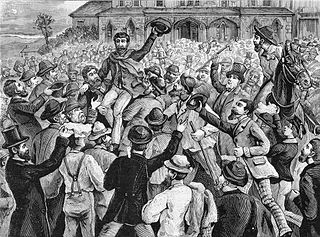In law, provocation is when a person is considered to have committed a criminal act partly because of a preceding set of events that might cause a reasonable person to lose self control. This makes them less morally culpable than if the act was premeditated (pre-planned) and done out of pure malice. It "affects the quality of the actor's state of mind as an indicator of moral blameworthiness".
In criminal law, entrapment is a practice whereby a law enforcement agent or agent of the state induces a person to commit a criminal offense that the person would have otherwise been unlikely or unwilling to commit. It "is the conception and planning of an offense by an officer or agent, and the procurement of its commission by one who would not have perpetrated it except for the trickery, persuasion or fraud of the officer or state agent."
Obstruction of justice, in United States jurisdictions, is a crime consisting of obstructing prosecutors, investigators, or other government officials. Common law jurisdictions other than the United States tend to use the wider offense of perverting the course of justice.

In common law jurisdictions, an acquittal certifies that the accused is free from the charge of an offense, as far as the criminal law is concerned. This is so even where the prosecution is simply abandoned by the prosecution. The finality of an acquittal is dependent on the jurisdiction. In some countries, such as the United States, an acquittal operates to bar the retrial of the accused for the same offense, even if new evidence surfaces that further implicates the accused. The effect of an acquittal on criminal proceedings is the same whether it results from a jury verdict or results from the operation of some other rule that discharges the accused. In other countries, the prosecuting authority may appeal an acquittal similar to how a defendant may appeal a conviction.
Apprendi v. New Jersey, 530 U.S. 466 (2000), is a landmark United States Supreme Court decision with regard to aggravating factors in crimes. The Court ruled that the Sixth Amendment right to a jury trial, incorporated against the states through the Fourteenth Amendment, prohibited judges from enhancing criminal sentences beyond statutory maxima based on facts other than those decided by the jury beyond a reasonable doubt. The decision has been a cornerstone in the modern resurgence in jury trial rights. As Justice Scalia noted in his concurring opinion, the jury-trial right "has never been efficient; but it has always been free."
Transferred intent is a legal doctrine that holds that, when the intention to harm one individual inadvertently causes a second person to be hurt instead, the perpetrator is still held responsible. To be held legally responsible under the law, usually the court must demonstrate that the person has criminal intent, that is, that the person knew another would be harmed by his or her actions and wanted this harm to occur. If a murderer intends to kill John, but accidentally kills George instead, the intent is transferred from John to George, and the killer is held to have had criminal intent.
The United States Federal Sentencing Guidelines are rules that set out a uniform policy for sentencing individuals and organizations convicted of felonies and serious misdemeanors in the United States federal courts system. The Guidelines do not apply to less serious misdemeanors.
The Hobbs Act, named after Congressman Sam Hobbs (D-AL) and codified at 18 U.S.C. § 1951, is a U.S. federal law enacted in 1946 that provides:
(a) Whoever in any way or degree obstructs, delays, or affects commerce or the movement of any article or commodity in commerce, by robbery or extortion or attempts or conspires to do so, commits, or threatens physical violence to any person or property in furtherance of a plan or purpose to do anything in violation of this section shall be fined under this title or imprisoned not more than twenty years, or both.
Jones v. United States, 526 U.S. 227 (1999), is a United States Supreme Court case interpreting the federal carjacking statute, 18 U.S.C. § 2119, to set forth three distinct crimes, each with distinct elements. The Court drew this conclusion from the structure of the statute, under which two subsections provided for additional punishment if the defendant inflicts more serious harm. The Court also distinguished Almendarez-Torres v. United States, 523 U.S. 224 (1998), because that case allowed for sentencing enhancement based on a prior conviction.
Holloway v. United States, 526 U.S. 1 (1999), is a United States Supreme Court case in which the court addressed the issue of whether the federal carjacking law applies to crimes committed with the "conditional intent" of harming drivers who refuse a carjacker's demands.
Maryland State Commission on Criminal Sentencing Policy, (MSCCSP), is an agency within the state government of Maryland, that sets guidelines which are used by Maryland circuit court judges in sentencing persons convicted of crimes in the state.

Stephen Joseph Murphy III is a United States District Judge of the United States District Court for the Eastern District of Michigan.
The Double Jeopardy Clause of the Fifth Amendment to the United States Constitution provides: "[N]or shall any person be subject for the same offence to be twice put in jeopardy of life or limb..." The four essential protections included are prohibitions against, for the same offense:
Child pornography laws in the United States specify that child pornography is illegal under federal law and in all states and is punishable by up to 20 years' imprisonment or fine of $5000. The Supreme Court of the United States has found child pornography to be "legally obscene", a term that refers to offensive or violent forms of pornography that have been declared to be outside the protections of the First Amendment to the United States Constitution. Federal sentencing guidelines on child pornography differentiate between production, distribution, and purchasing/receiving, and also include variations in severity based on the age of the child involved in the materials, with significant increases in penalties when the offense involves a prepubescent child or a child under the age of 12. U.S. law distinguishes between pornographic images of an actual minor, realistic images that are not of an actual minor, and non-realistic images such as drawings. The latter two categories are legally protected unless found to be obscene, whereas the first does not require a finding of obscenity.
Honest services fraud is a crime defined in 18 U.S.C. § 1346, added by the United States Congress in 1988, which states "For the purposes of this chapter, the term scheme or artifice to defraud includes a scheme or artifice to deprive another of the intangible right of honest services."
Threatening the president of the United States is a federal felony under United States Code Title 18, Section 871. It consists of knowingly and willfully mailing or otherwise making "any threat to take the life of, to kidnap, or to inflict bodily harm upon the president of the United States". This also includes presidential candidates and former presidents. The United States Secret Service investigates suspected violations of this law and monitors those who have a history of threatening the president. Threatening the president is considered a political offense. Immigrants who commit this crime can be deported.
Acceptance of responsibility is a provision in the United States Federal Sentencing Guidelines providing for a decrease by 2 or 3 levels in offenders' offense level for admitting guilt and otherwise demonstrating behavior consistent with acceptance of responsibility, such as ending criminal conduct and associations. It amounts to a sentence reduction of about 35%. The 3-level reduction is only available to defendants with an offense level of 16 or greater, and it requires a timely guilty plea. Federal plea agreements usually include a stipulation that the government will support granting the defendant the acceptance of responsibility reduction. The guideline states, in reference to the 2-level reduction:

United States federal probation and supervised release are imposed at sentencing. The difference between probation and supervised release is that the former is imposed as a substitute for imprisonment, or in addition to home detention, while the latter is imposed in addition to imprisonment. Probation and supervised release are both administered by the U.S. Probation and Pretrial Services System. Federal probation has existed since 1909, while supervised release has only existed since 1987, when it replaced federal parole as a means for imposing supervision on release from prison.
Aiding and abetting is a legal doctrine related to the guilt of someone who aids or abets in the commission of a crime. It exists in a number of different countries and generally allows a court to pronounce someone guilty for aiding and abetting in a crime even if they are not the principal offender.
United States v. Antelope, 430 U.S. 641 (1977), was a United States Supreme Court case in which the Court held that American Indians convicted on reservation land were not deprived of the equal protection of the laws; (a) the federal criminal statutes are not based on impermissible racial classifications but on political membership in an Indian tribe or nation; and (b) the challenged statutes do not violate equal protection. Indians or non-Indians can be charged with first-degree murder committed in a federal enclave.






